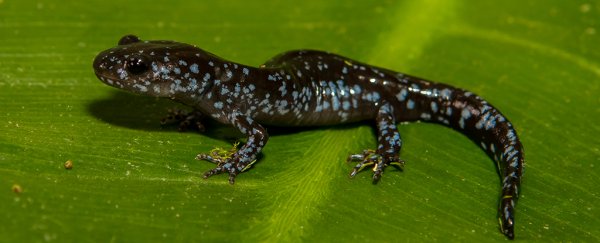A species of salamander known for only producing female offspring has been observed using genetic material stolen from males of other species in equal measures.
This is the first time biologists have analysed the balance of genetic expression in a hybrid species of animal with more than two genomes, and they've discovered what has to be one of the most feminist acts of nature.
A team led by researchers from the University of Iowa took a close look at the rather unusual genome of a population of mole salamander (Ambystoma) to determine if it has a preference for a particular set of its genes.
Humans - like many animals - tend to be what are called diploid organisms. In simple terms, that means most of our cells contain two sets of chromosomes, those long strings of DNA that contain sequences of genes.
We typically get one set of chromosomes from each of our two parents, and while recent research has questioned whether all of our cells treat each parent's genes equally, in general it's accepted that our bodies don't play favourites.
Some species of Ambystoma do things a little differently - they're part of a select group of vertebrates that happen to be polyploid, which means they possess more than two sets of chromosomes.
Specifically, many populations of all-female mole salamander range from triploid to pentaploid, having between three and five sets of chromosomes.
These amphibians are also parthenogenetic, which means their offspring are usually clones of the mother, inheriting the complete allotment of chromosomes directly from her.
That's not to say they've done away with sex altogether - they still seek a male from another closely related species, have a quick dalliance, and use their sperm to kickstart the reproduction process.
Usually the sperm are discarded after they've triggered the egg cells into dividing, but these amphibian Amazonians have another trick up their sleeve -sometimes they'll steal some of the sperm's genetic material, an act biologists call kleptogenesis.
That means the triploid genome of unisex Ambystoma populations can include genetic material from different father lineages - one paternal lineage for each chromosome set.
The fathers in this study came from the three species: Ambystoma laterale, Ambystoma texanum, and Ambystoma tigrinum.
Since polyploid organisms - especially plants - often turn off genes they have multiple copies of, the researchers wondered if the unisex Ambystoma were particular about which lineage of genes they used.
It turns out they weren't all that choosy.
"It's mostly balanced. The three genomes are mostly being expressed equally in this hybrid," said researcher Kyle McElroy.
The team analysed just under 3,000 genes common to each chromosome and found that 72 percent of the genes were expressed equally by each set.
It's likely that there's a good reason that the salamanders aren't prioritising any one genetic line.
"This balance might have been a prerequisite for the emergence and continued success of this particular hybrid lineage," said researcher Maurine Neiman.
One possibility is it allows the population to remain adaptable to its surroundings. While one set of genes might give it an advantage now, a relatively swift change in the environment might then spell doom.
McElroy gave an analogy of a sporting team, where you don't lean too hard on one player's strategy.
"If you have a team that's unbalanced and loses a top player, you won't win," said McElroy. "But if every player is equal, then you don't lose as much."
Keeping it simple and not using complicated processes to pick the best genes seems to have been a winning strategy for these gene thieving, promiscuous, all-female mole salamanders.
This research was published in Genome Biology and Evolution.
